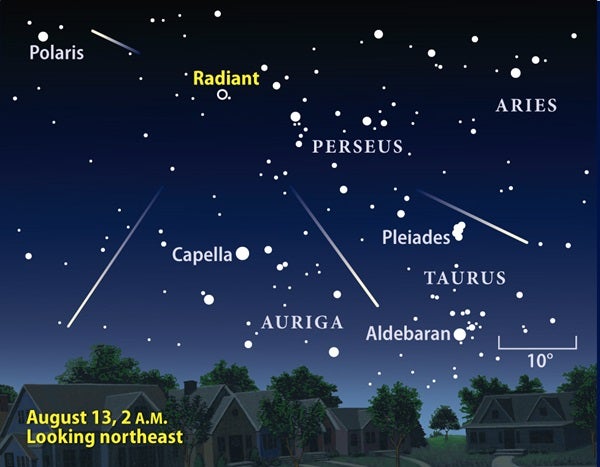One of the year’s best meteor showers will peak during the early morning hours of August 13 under a moonless sky. “The waxing crescent Moon sets before twilight ends, so the best viewing of the Perseid meteor shower will be after midnight,” said Astronomy Senior Editor Richard Talcott.
Observers can expect to see more than 60, and perhaps 100, meteors per hour. About half as many will be visible the night before and after.
The particles we see as meteors originated from Comet 109P/Swift-Tuttle. As Earth runs into the particle stream in its orbit every year, we view the bright, fast meteors as they hit Earth’s atmosphere at 37 miles per second.
As always, you’ll see more meteors if you observe from a dark location. It’s also best to view meteor showers without optical aid. Viewers should use just their eyes, so as not to restrict the field of view.
Meteor showers offer everyone, not just avid amateur astronomers, a chance to witness a cosmic spectacle. Meteor showers are great social and family events. Organize a group of skygazers and head out of town to a dark location. Bring lawn chairs to ease neck strain, and don’t forget the bug spray and a blanket.
- Most visible meteors lie within 120 miles (200 kilometers) of an observer.
- Meteors become visible at an average height of 55 miles (90 km). Nearly all burn up before they reach an altitude of 50 miles (80 km).
- No known meteorite has been associated with a meteor shower. (That is, no shower meteor has ever survived its flight through the atmosphere and been recovered.)
- The typical bright meteor is produced by a particle with a mass less than 1 gram and with a size no larger than a pea.
- The average total mass of meteoritic material entering the Earth’s atmosphere is estimated to be between 100 and 1,000 tons (91,000 and 910,000 kilograms) per day.
- The hourly rate on a “non-shower” night is approximately 6 meteors per hour.
- A meteoroid enters the atmosphere at velocities between 25,000 and 165,000 mph (40,300 and 265,000 km/h).
- Video: How to observe meteor showers
- Podcast: Observe the 2010 Perseid meteor shower
- StarDome: Locate the Perseid meteor shower’s radiant in your night sky with our interactive star chart.
- Sign up for our free weekly e-mail newsletter.












